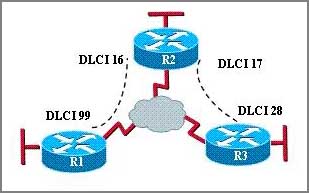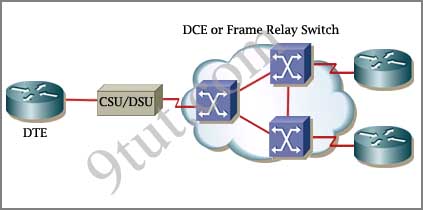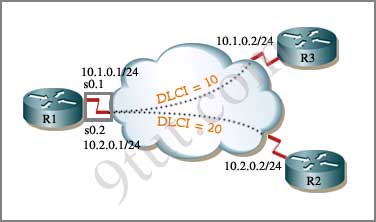CCNA – WAN
Here you will find answers to WAN Questions
If you are not sure about Frame Relay, please read my Frame Relay tutorial.
Question 1
The command frame-relay map ip 10.121.16.8 102 broadcast was entered on the router. Which of the following statements is true concerning this command?
A: This command should be executed from the global configuration mode.
B: The IP address 10.121.16.8 is the local router port used to forward data.
C: 102 is the remote DLCI that will receive the information.
D: This command is required for all Frame Relay configurations.
E: The broadcast option allows packets, such as RIP updates, to be forwarded across the PVC.
Correct Answers: E
Explanation:
The command frame-relay map ip 10.121.16.8 102 broadcast means to mapping the distal IP 10.121.16.8 102 to the local DLCI 102. When the “broadcast” keyword is included, it turns Frame Relay network as a broadcast network, which can forward broadcasts
Question 2
Refer to the exhibit. Which statement describes DLCI 17?

A: DLCI 17 describes the ISDN circuit between R2 and R3.
B: DLCI 17 describes a PVC on R2. It cannot be used on R3 or R1.
C: DLCI 17 is the Layer 2 address used by R2 to describe a PVC to R3.
D: DLCI 17 describes the dial-up circuit from R2 and R3 to the service provider.
Correct Answers: C
Explanation:
DLCI stands for Data Link Connection Identifier. DLCI values are used on Frame Relay interfaces to distinguish between different virtual circuits. DLCIs have local significance because the identifier references the point between the local router and the local Frame Relay switch to which the DLCI is connected.
Question 3
A default Frame Relay WAN is classified as what type of physical network?
A: point-to-point
B: broadcast multi-access
C: nonbroadcast multi-access
D: nonbroadcast multipoint
E: broadcast point-to-multipoint
Correct Answer: C
Explanation:
Non-Broadcast Multi-Access (NBMA) networks are types such as Frame Relay, X.25, and Asynchronous Transfer Mode (ATM). These networks allow for multi-access, but have no broadcast ability like Ethernet
Question 4
Which of the following are key characteristics of PPP? (Choose three.)
A: can be used over analog circuits
B: maps Layer 2 to Layer 3 address
C: encapsulates several routed protocols
D: supports IP only
E: provides error correction
Correct Answers: A C E
Explanation
Below is some more information about PPP:
PPP (Point-to-Point Protocol) allows authentication such as Password Authentication Protocol (PAP) and Challenge Handshake Authentication Protocol (CHAP) and multilink connections (allow several separate physical paths to appear to be one logical path at layer 3) and can be run over asynchronous and synchronous links.
PPP can work with numerous network layer protocols, including Internet Protocol (IP), Novell’s Internetwork Packet Exchange (IPX), NBF and AppleTalk.
PPP only supports error detection, not error correction so answer E should be understood as “provides error detection”. It is a mistake of this question.
Question 5
Which three Layer 2 encapsulation types would be used on a WAN rather than a LAN? (Choose three)
A: HDLC
B: Ethernet
C: Token Ring
D: PPP
E: FDDI
F: Frame Relay
Correct Answer: A D F
Question 6
Refer to the exhibit. What is the meaning of the term dynamic as displayed in the output of the show frame-relay map command shown?

A: The Serial0/0 interface is passing traffic.
B: The DLCI 100 was dynamically allocated by the router
C: The Serial0/0 interface acquired the IP address of 172.16.3.1 from a DHCP server
D: The DLCI 100 will be dynamically changed as required to adapt to changes in the Frame Relay cloud
E: The mapping between DLCI 100 and the end station IP address 172.16.3.1 was learned through Inverse ARP
Correct Answer: E
Explanation
The term dynamic indicates that the DLCI number and the remote router IP address 172.16.3.1 are learned via the Inverse ARP process.
Inverse ARP is a technique by which dynamic mappings are constructed in a network, allowing a device such as a router to locate the logical network address and associate it with a permanent virtual circuit (PVC).
Question 7
Which of the following describes the roles of devices in a WAN? (Choose three.)
A: A CSU/DSU terminates a digital local loop
B: A modem terminates a digital local loop
C: A CSU/DSU terminates an analog local loop
D: A modem terminates an analog local loop
E: A router is commonly considered a DTE device
F: A router is commonly considered a DCE device
Correct Answers: A D E
Explanation
The idea behind a WAN is to be able to connect two DTE networks together through a DCE network. The network’s DCE device (includes CSU/DSU) provides clocking to the DTE-connected interface (the router’s serial interface).

A modem modulates outgoing digital signals from a computer or other digital device to analog signals for a conventional copper twisted pair telephone line and demodulates the incoming analog signal and converts it to a digital signal for the digital device. A CSU/DSU is used between two digital lines -> A & D are correct but B & C are not correct.
For more explanation of answer D, in telephony the local loop (also referred to as a subscriber line) is the physical link or circuit that connects from the demarcation point of the customer premises to the edge of the carrier or telecommunications service provider’s network. Therefore a modem terminates an analog local loop is correct.

Question 8
How should a router that is being used in a Frame Relay network be configured to avoid split horizon issues from preventing routing updates?
A: Configure a separate sub-interface for each PVC with a unique DLCI and subnet assigned to the sub-interface
B: Configure each Frame Relay circuit as a point-to-point line to support multicast and broadcast traffic
C: Configure many sub-interfaces on the same subnet
D: Configure a single sub-interface to establish multiple PVC connections to multiple remote router interfaces
Correct Answer: A
Explanation
Look at the figure below:

In the figure, router R1 has two point-to-point subinterfaces. The s0.1 subinterface connects to router R3 and the s0.2 subinterface connects to router R2. Each subinterface is on a different subnet.
Question 9
What can a network administrator utilize by using PPP Layer 2 encapsulation? (Choose three.)
A: VLAN support
B: compression
C: authentication
D: sliding windows
E: multilink support
F: quality of service
Correct Answers: B C E
Explanation
Same as question 4
Question 10
The Frame Relay network in the diagram is not functioning properly. What is the cause of the problem?

A: The Gallant router has the wrong LMI type configured
B: Inverse ARP is providing the wrong PVC information to the Gallant router
C: The S3 interface of the Steele router has been configured with the frame-relay encapsulation ietf command
D: The frame-relay map statement in the Attalla router for the PVC to Steele is not correct
E: The IP address on the serial interface of the Attalla router is configured incorrectly
Correct Answer: D
Explanation
At Attalla router, we find a deleted status but the next map statement indicates an active status, which if for Gallant. Therefore we can deduce the map statement for the PVC from Attalla to Steele is incorrect. Incorrect DLCI assignments that are configured normally shown up as “deleted” in the frame relay maps.



Can someone tell me how to execute the lab. I cant figured out.
I: meant the lab sims.
thnxxxxxxxxxxxx God
my score 894 /1000
any body neeed any question contact me on my-mail
eng_hijazin@hotmail
it’s verrrrrrrrrrrrrrrrrrry easy Cheeeerz
wich command allows you to verify the encapsulation type(Cisco; Ietf) :
1*show framerelay map
2*show framerelay lmi
3*show framerelay pvc
4*show inter serial
Answer :- sh framerelay lmi
hi,
can anyone send me the latest dumps? I’ll take my CCNA exam next friday…
thanks,
andrew.letcon@gmail.com
I would like the latest updates too if anyone has them
Hi guys!
Here is the correct answer to the question “Which command allows you to verify the encapsulation type (Cisco or IETF)?”
A) show frame-relay map
B) show frame-relay lmi
C) show frame-relay pvc
D) show interface serial X/X
Correct answer is D. Here is a pic why: http://img534.imageshack.us/img534/3417/ietf.png
The show frame-relay map shows the local DLCI, the remote IP address, the method of learning (dynamic by RARP or static) and the status (active, inactive, deleted), so A is incorrect.
The show frame-relay lmi shows the local management interface’s type (ansi, cisco or q933a, so B is incorrect too.
The show frame-relay pvc shows some FECN/BECN/blablabla, the LMI type, and the interface number, so C is incorrect
hi ..my exam ccna next month can help me last dumps to PDF using VisualCertExam. plz
i got this explaination from cisco course dont confuse LMI and encapsulation(Cisco,Ieft)
so the answer is definetly 1
wich command allows you to verify the encapsulation type(Cisco; Ietf) :
1*show framerelay map
2*show framerelay lmi
3*show framerelay pvc
4*show inter serial
Explaination of detail of sh fr map
the show frame-relay map command. The DLCI identifies the logical connection being used to reach this interface. This value is displayed in three ways: its decimal value (102), its hexadecimal value (0×66), and its value as it would appear on the wire (0×1860). This is a static entry, not a dynamic entry. The link is using Cisco encapsulation as opposed to IETF encapsulation.
hope it help french speaker from geneva..
I agree with this article that coicifrtatien certainly do give you an edge. Like the writer, I have seen this myself being an I.T recruiter for a period of time. The Cisco Certifications have industry respect because the exams are more difficult than others, and they require you to recertify every 3 years in order to be up-to-date with the current technologies.If you want to get into networking, Cisco certs are the way to go.
These dumps are VERY accurate! If you know what you’re doing with Cisco equipment, and use these as practice questions you will pass your CCNA.
I passed my CCNA today with an 894. Good luck everyone!
@ DrZoo : what about the sims ? were they exactly the same ?? and other questions ?
I’m taking my test Monday can someone send me dumps at spivy66@gmail.com
Guys, I really don’t understand logic of DLCIs.
What does it mean – local significant?
Wendell Odom writes there are two kind of DLCIs exist: local DLCIs and global DLCIs.
E.g. in this exibition: http://www.9tut.com/images/ccna/wanquestions/wandlciunderstand5.jpg
How many DLCIs should we use in this case? 3 or 4? Maybe 6?!
Hello Please help:
A network Adm config a serial link between main office and remote location. The route at the remote office is a non-cisco. How to config the serial interface to make the connection
A.
R1 (config)# interface serial 0
R1(config-if)#ip address 172.16.1.1 255.255.255.252
R1 (config-it)# encapsulation PPP
R1 (config-it)# no shutdown
B.
R1 (config)# interface serial 0
R1(config-if)#ip address 172.16.1.1 255.255.255.252
R1 (config-it)# encapsulation ietf
R1 (config-it)# no shutdown
I think is B but the dumps say is A . can you explain please
@CP
IETF itself is not an encapsulation option on an interface; it is used in frame relay
networks, where the encapsulation can be frame relay IETF, but not simply IETF alone. Hence, choice B is not correct.
The default encapsulation on a serial interface is the Cisco proprietary HDLC. When
connecting to routers from another vendor, we will need to use the standards based PPP, or frame relay IETF.
which is correctly defined in choice A
Dear all,
you may also want to check below site for some useful resources. Good luck to all of us!
careercert.info
today i passed with 986 score……..
this was question asked in my exam :-
A network administrator needs to configure a serial link between the main office
Question :A network administrator needs to configure a serial link between the main office
and a remote location. The router at the remote office is a non-Cisco router.
How should the network administrator configure the serial interface of the main
office router to make the connection?
A. Main(config)# interface serial 0/0
Main(config-if)# ip address 172.16.1.1 255.255.255.255
Main(config-f)# no shut
B. Main(config)# interface serial 0/0
Main(config-if)# ip address 172.16.1.1 255.255.255.255
Main(config-f)# encapsulation ppp
Main(config-if)# no shut
C. Main(config)# interface serial 0/0
Leading the way in IT testing and certification tools, http://www.testking.com
- 219 -
Main(config-if)# ip address 172.16.1.1 255.255.255.255
Main(config-f)# encapsulation frame-relay
Main(config-if)# authentication chap
Main(config-if)# no shut
D. Main(config)# interface serial 0/0
Main(config-if)# ip address 172.16.1.1 255.255.255.255
Main(config-f)# encapsulation ietf
Answer :B
could i get latest dumps please? Does asking for them in email even work? planning to take exam end of May
@ rayjr75@yahoo.com
forget it man,,,,,,,,, no one is going to email you anything……….
you have to do it yourself……….
YOU CAN DOWNLOAD ALL DUMPS FREE FROM THIS SITE :-
http://www.examcollection.com/640-802.html
What is the result of issuing the frame-relay map ip 192.168.1.2 202 broadcast
command?
A.defines the DLCI that is used for all packets that are sent to the 192.168.1.2 IP address
B.defines the source IP address that is used in all broadcast packets on DCLI 202
C.defines the DLCI on which packets from the 192.168.1.2 IP address are received
D.defines the destination IP address that is used in all broadcast packets on DCLI 202
Can anyone help?
i had 5th question in my exam but atm option is there instead of framerelay.
D. destination ip to local dlci 202
q10. the correct answer could be E.
If you noticed, IP Address on Atalla is on different subnet with Gallant and Steele.
And this is hub-and-spoke topology, based on CNAP, these router should be in 1 subnet.
CMIIW
Addition, based on cisco support, “status deleted” means the provider deleted/removed the DLCI, so I prefer answer E
correction, I misread the IP, I think it’s .128, sorry :D
the correct answer is still D
Hi all, I am taking CCNA 640-802 exam first time on 30/05/2012. Could anyone please send me latest dumps which are valid for UK? My e-mail address is puneet_gill84@yahoo.co.uk. Many thanks.
is it possible to get these questions in pdf form so i can have them on my nook? please let me know if there is a valid free link riveradenise12@gmail.com
hi ..any one answer & ex plane the q. plz
what dose the fram-relay interface-dlci command configure?
a- remot dlci on the sub interface
b- remot dlci on the main interface
c-local dlci on the main interface
d- remot dlci on the sub interface
sorry d-local dlci on the sub interface
Hi everybody pls i need your help i will take the exames in August and I rly wana know if all the questions that we found in 9tut now or shuld i tk a questions one month before?
I PASSED CCNA EXAM TODAY THANKS TO ALL MIGHTY ALLAH
960/1000
Why when I use VCE for the dumps, I only see 5 questions and they say you have to register or something?
@Aleesa: I think you have to get VCE full version somehow I had same problem but I had to use my old laptop which had VCE installed! let see if someone else has any better suggestions.
@BMW, i’ll try looking for a full version, thanks.
Hi, Im Priya from Kerala(India).Im taking ccna exam on 30th June.Really im fed up.Can any one plz send me latest dumps to my email priya.ccna@yahoo.in Love you all .God Bless ..Thanks
priya
@Aleesa i will tried to help you in$alla please write your e-mail and i will sending you 632 exam questions on VCE
hi 9tut and xallax..
can you help me with the question below.
http://i45.tinypic.com/infi8z.gif
according to dump the answer is C. why?
thanks.
@jay
frame-relay map ip NEIGHBOR_IP NEIGHBOR_DLCI [should it be broadcast]
on the given exhibit the dlci was the one of the local router, not the neighbor
@xallax,
precisely, you map the remote ip address to local DLCI of the router. In this case Router 1 map its DLCI 100 to router 2 ip address, 192.16.100.1 am i correct?
Thanks in advance.
@jay
if the ip address 172.16.100.1 is the address of the neighboring router (DLCI 200), then you are correct: the map statement is a correct one.
@ahmed
then whats wrong with the exhibit.
http://i45.tinypic.com/infi8z.gif
thanks in advance.
hi ..any one answer & ex plane the q. plz
what dose the fram-relay interface-dlci command configure?
a- remot dlci on the sub interface
b- remot dlci on the main interface
c-local dlci on the main interface
d-local dlci on the sub interface
@jay
the output given is wrong, the DLCI should be 200 not 100.
@jay
check this out,
http://s1076.photobucket.com/albums/w458/mockgarvotz/?action=view¤t=DLCI.jpg
@9tut
hello, do you have a tutorial on the config for frame -relay?
thanks in advance, i am beginning to digest all that i’ve learned from my cisco training haha! you’ve got a wonderful site here.
God bless!
regards,
confused
@confused:
Frame Relay tutorial: http://www.9tut.com/frame-relay-tutorial
Frame Relay Configuration GNS3 Lab: http://www.9tut.com/frame-relay-gns3-lab
hi i am fatma from egypt please Can any one plz send me latest dumps to my email (fatma.thabet.89@gmail.com)
Hi 9tut and xallax,
I would like to ask if the ISDN technology is included in WAN topic.
thanks.
@ Shawosh and Awash
i see. Thank you.